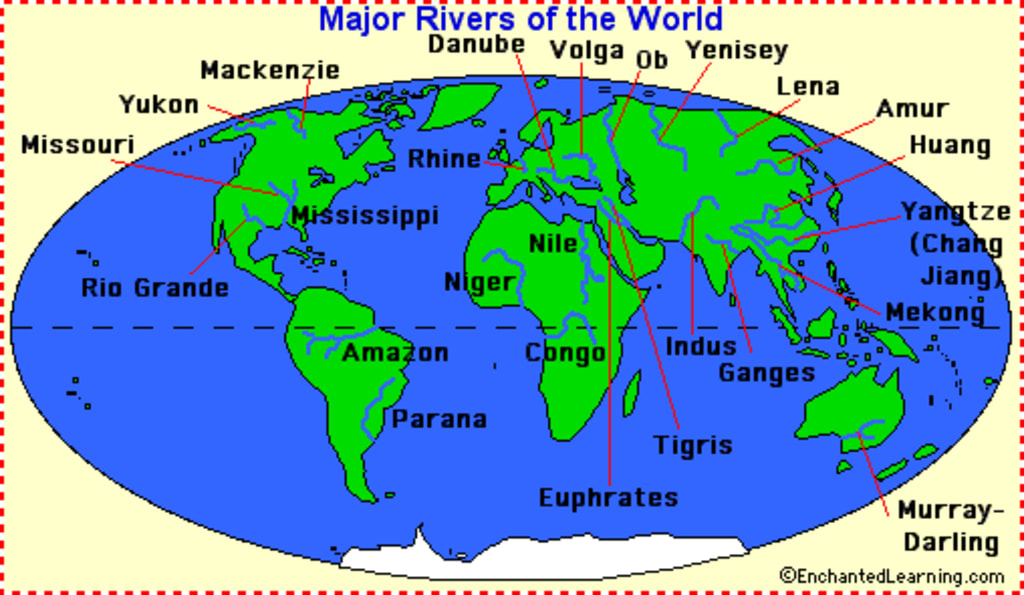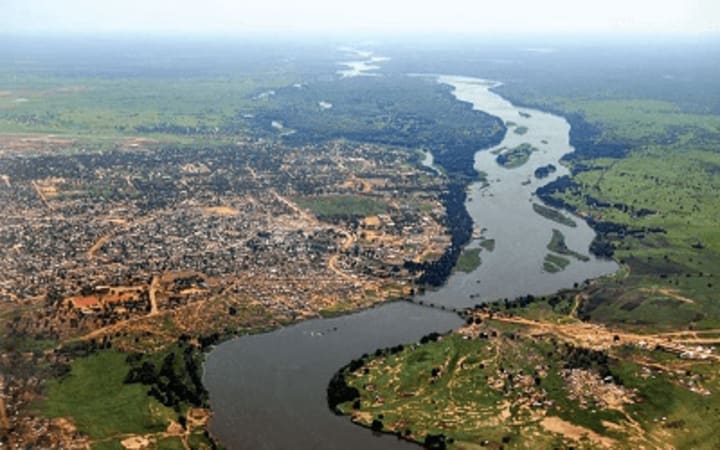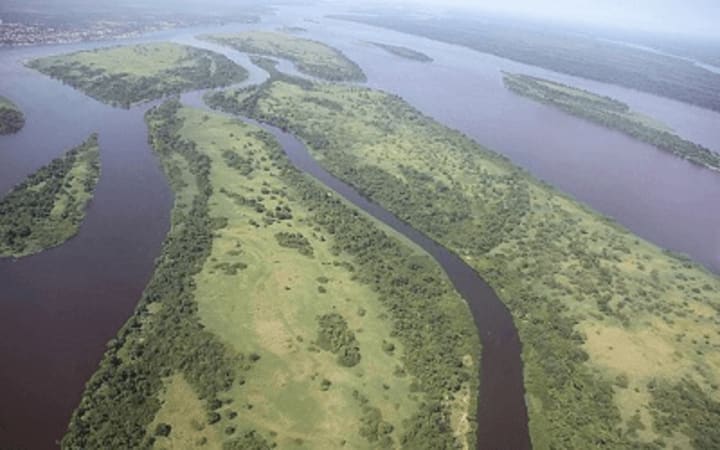Top 10 Longest Rivers in The World
A river is a stream of water that has the shape of a ribbon and moves downward under the pull of gravity. A river may be wide and deep or it may be narrow enough to cross by wading. A stream, creek, or brook is a smaller flowing body of water than a river. Some rivers run all year, while others flow during certain seasons or particularly heavy rain. Thousands of miles of river can be found in the world's major rivers. Geological wonders like the Grand Canyon can be produced by rivers' erosional power.

Every river has a point where the water begins to flow. A headwater is a name for this type of source. Rainfall or snowfall in the mountains can give the headwater source, but it can also erupt from the earth or form at the boundary of a lake or huge pond. A river's mouth is where the water drains into a larger body of water like a lake or the ocean. Rivers may pass through wetlands along the course, where plants filter pollutants out of the water.
River water is fresh, which means it has less than 1% salt content. Scientists estimate that the world's rivers transport around 3.6 billion metric tonnes (four billion tonnes) of salt from land to sea each year. On the other hand, Rivers continue to transport and distribute vital minerals and nutrients required for plant and animal life to thrive. As a result, rivers are home to some of the world's most biodiverse ecosystems.
The Hudson River in New York, United States, is an example of an estuary with brackish water that extends more than 241 kilometers (150 miles) upstream. Rivers can also produce an estuary formed when salty seawater meets with freshwater near the river mouth to create "brackish water."
Rivers that overflow their bank's deposit silt in the flood plains surrounding them. Sand, silt, and pebbles are all transported by swift-moving rivers. As the river expands, these sediments sink and build up to generate deltas as the river slows down? as in a marsh, on the edge of a curve, or at the mouth. These deltas and floodplains are exceptionally fruitful agricultural zones with enormous economic importance for nearby people. The Nile River and its delta, for example, were instrumental in the formation of the Egyptian empire that built the pyramids.
Humans use rivers for various purposes, including irrigation, drinking water, transportation, energy generation via hydroelectric dams, and recreational activities such as swimming and boating. Each of these uses can negatively impact a river's health and its ecosystems. The condition of rivers, lakes, and streams is inspected by limnologists, or water scientists.
Animals
Freshwater animals and plants can be found in abundance in rivers, lakes, and streams. Hundreds of different species can coexist in a single aquatic ecosystem, and freshwater ecosystems can be found worldwide.
Though conceptually similar, food webs more accurately depict the many interactions that take place in an ecosystem than do food chains. A food web represents all of the food chains in an ecosystem and, consequently, all of the various species interactions, as opposed to following a single energy pathway. The river otter, for example, might be included first, followed by the snake, fish, frog, and insect in a food chain showing freshwater species and plants.
Rivers are freshwater environments home to more than 100,000 plants and animals. The Mississippi River alone boasts around 120 fish species in its waters in the United States. On the other hand, Rivers are home to much than simply fish. There are several other species, including ones that have developed specialized underwater survival methods.
The study of the river's voyage demands constructing a list of the world's top 10 longest rivers and their lengths and courses. Understanding the river's route might also help you comprehend the area's demography.
1. Nile River (6650 km)

The Nile River is renowned as the world's longest river. The length of the Nile River is about 6650 kilometers. The river's source is assumed to be Lake Victoria. Egypt, Uganda, Ethiopia, Kenya, Tanzania, Rwanda, the Democratic Republic of the Congo, Eritrea, Burundi, Sudan, and South Sudan are all situated along the river. The river's two tributaries are the Blue and White Niles. Although most of us conceive of the Nile River as the world's longest river, some experts feel the Amazon River is the actual winner. There are many origins and many small and major tributaries for huge rivers like the Nile and the Amazon.
At Ripon Falls, which are close to Jinja, Uganda, the Victoria Nile emerges from Lake Victoria. 130 kilometers north of Lake Kyoga, it runs. The remaining 200 kilometers of the river section starts on the lake's western banks and goes west until just south of Masindi Port, when it swings north, then makes a massive half circle to the east and north until it reaches Karuma Falls. It continues westerly via the Murchison Falls for the remainder of its journey until it reaches the far northern beaches of Lake Albert, where it forms a large river delta.
2. Amazon River (6575 km)

In terms of water flow volume, the Amazon River is, without a doubt, the world's largest river. However, its claim to being the world's second-longest river is widely contested, as Egypt's Nile River has long held the title. The basis of the argument is the debate concerning Amazon's beginnings. According to a report released in 2014, Amazon originated in the Cordillera Rumi Cruz. The Amazon accounts for 20% of worldwide riverine flow into the oceans. The average annual flow of the Amazon River is over 209,000 m3/s, or around 6,591 km3 (1,581 cu mi), which is more than the combined annual discharge of the following seven largest independent rivers. Two of the top 10 rivers in terms of discharge are Amazon tributaries. With approximately 7,000,000 km2, the Amazon basin is the world's largest drainage basin. The river's drainage basin is bigger than any other river's alone in Brazil. Even though it only has a fifth of the flow, the Amazon eventually empties into the Atlantic Ocean as it enters Brazil; at this point, it already has a larger flow than any other river.
3. Yangtze River (6300 km)

The Yangtze River is the longest river in the world that flows wholly inside a single nation, ranking third overall. Additionally, it is Asia's longest river. The Yangtze River basin is home to one-third of the population of China, the world's most populous nation. The Chinese government has historically identified the Tuotuo tributary in the Tanggula Mountains as the river's source. These and other tributaries combine to form the Yangtze River, which at Shanghai empties into the East China Sea. The Yangtze River's source, according to new information, is on Jari Hill, where the Dam Qu tributary's headwaters arise.
4. Mississippi River (6275 km)

The Mississippi, Missouri, and Jefferson rivers compose the fourth-longest river system in the world. The river system drains 31 US states as well as two Canadian provinces. The Mississippi River is said to have its origins in the Lake Itasca in northern Minnesota before flowing into the Gulf of Mexico. The Mississippi-Missouri-Jefferson river system was formed when the Jefferson River was considered the Mississippi River's farthest source. It runs south for 2,340 miles (3,770 kilometers) from its original source of Lake Itasca in northern Minnesota to the Mississippi River Delta in the Gulf of Mexico. Thanks to its many tributaries, the Mississippi's watershed drains all or sections of 32 US states and two Canadian provinces between the Rocky and Appalachian ranges. The Mississippi River is split into three sections: the Upper Mississippi, which runs from its headwaters to the Missouri River's confluence; the Middle Mississippi, which runs from Missouri to the Ohio River; and the Lower Mississippi, which runs from Ohio to the Gulf of Mexico.
5. Yenisei River (5539 km)

This is the world's fifth-longest river system and the Arctic Ocean's biggest. The Selenge River is the river system's headwaters. The Selenge River has a length of 992 km and drains into Lake Baikal. The Angara River rises in Lake Baikal near Listvyanka, travels through Russia's Irkutsk Oblast, and empties into the Yenisei River close to Strelka. Eventually, the Yenisei empties into the Arctic Ocean. 5,539 km was the total distance travelled.
The Yenisey valley is home to a rich diversity of flora and animals, including Siberian pine and Siberian larch trees. The Yenisey basin is home to 55 different native fish species (excluding Lake Baikal and the Khantayka headwaters).
A line that went from the Yenisey to the Chinese border and then along the Chinese-Soviet Union border was chosen by Nazi Germany and the Japanese Empire to divide Asia during World War II. According to investigations, the Yenisey has been polluted by radioactive discharges from a facility that processed bomb-grade plutonium in the secret city of Krasnoyarsk-26, now known as Zheleznogorsk.
6. Yellow River (5464 km)

This large river, also known as the Huang He, is called by the hue of the water, which is created by vast volumes of loose debris. Its basin is regarded as the origin of ancient Chinese civilization and has great symbolic and utilitarian significance for the nation. The Yellow River basin spans 1,900 kilometers (1,180 miles) from east to west and 1,100 kilometers (1,100 miles) from north to south (680 mi). It has a total area of about 795,000 square kilometers (307,000 sq. mi). The continual elevation of the river bed, sometimes above the level of its surrounding agricultural fields, produces repeated devastating floods and channel variations.
7. Ob-Irtysh River (5410 km)

The Ob-Irtysh, also referred to as the Ob River, is one of the three major Siberian rivers, along with the Yenisei and the Lena. It runs into the Arctic Ocean from the Altas Mountains. It is created where the rivers Biya and Katun, which both flow from the Altai Mountains, converge. Of the three main rivers in Siberia that flow into the Arctic Ocean, this one is the furthest to the west (the other two being the Yenisei and the Lena). Before repeating these orientations over a greater distance, it flows in a north-westerly direction, then northward. On its banks is Novosibirsk, the largest city in Siberia and the third-largest city in Russia. The river is crossed here by the Trans-Siberian Railway.
8. Parana River (4880 km)

One of the longest and second-largest rivers in the world, the Parana River traverses South America. The Rio Paraná and its tributaries form a vast drainage basin that covers all of Paraguay, part of southern Brazil, northern Argentina, and the southeast of Bolivia. The Rio Paraná's name is derived from the Tupi phrase para rehe onáva, "like the sea." The Rio Grande and Paranaiba rivers converge in southern Brazil to create the course. The river travels 619 kilometers (385 miles) southwest from the junction until reaching Saltos del Guaira, Paraguay.
9. Congo River (4700 km)

The Congo River, historically known as the Zaire River, runs through Africa's continent in a meandering pattern and is the only river to cross the equator twice. It is also the deepest river in the world, with certain locations reaching depths of about 700 feet. With 4,700 kilometers, the Congo-Lualaba-Chambeshi River System ranks ninth among all rivers in the world (2,920 mi). More than 220 meters deep, it is also the deepest river in the world (720 ft). The 1,800-kilometer-long Congo River upstream of Boyoma Falls is known as the Lualaba River, and it has a tributary by the name of the Chambeshi.
The hills and mountains of the East African Rift, Lake Tanganyika, and Lake Mweru provide water for the Lualaba River, which finally empties into the Congo below Boyoma Falls. Like the Nile River, the Chambeshi River in Zambia is often thought to be the source of the Congo. From Kisangani, right below the Boyoma Falls, the Congo runs northwest, then gradually bends southwest, passing through Mbandaka, joining the Ubangi River, and ultimately pouring into the Pool Malebo.
10. Amur River (4480 km)

Northeastern China's Amur River, commonly referred to as the Heilong Jiang, is the tenth-longest river in the world and runs along the boundary between China and Russia. The biggest fish species in the Amur, the Kaluga, may grow to lengths of up to 5.6 meters and is known in Chinese as Heilong Jiang, which translates to "black dragon river" (18 ft). The largest populations of the Amur softshell turtle and Indian lotus may be found in the river basin, along with northern snakehead, Amur pike, taimen, catfish, predatory carp, and yellow cheek.
There are at least 123 species of fish from 23 distinct families believed to live in the Amur. The Cypriniformes subfamily Gobioninae has the greatest number of members, followed by Salmonidae. The Acipenseridae family includes the sterlet, Kaluga, Amur, and Sakhalin sturgeons. The sturgeons of the Kaluga and Amur rivers are indigenous to those areas. In the 1950s, the sterlet was introduced from the Ob.
About the Creator
indika sampath
hello world
my name is indika sampath so I'm a article writer. you also can learn by reading somethings that important things.
thank you so much for visiting my profile






Comments
There are no comments for this story
Be the first to respond and start the conversation.